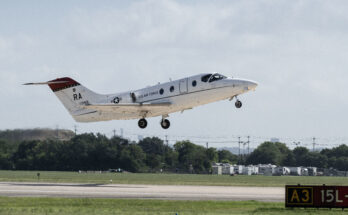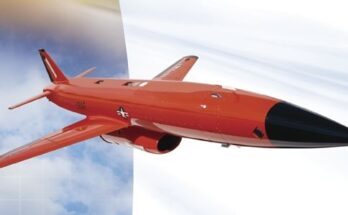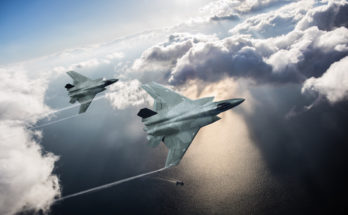
The U.S. Air Force Next Generation Air Dominance (NGAD) program is designed to replace the F-22 Raptor with a sixth-generation fighter capable of operating and achieving air superiority in the face of advanced integrated air defense systems and fighter aircraft, including aircraft like the Sukhoi Su-57 and China’s emerging inventory of stealth fighters. The Air Force plans for NGAD to incorporate a “family of systems” approach to create a new manned stealth fighter design that works seamlessly in combat with uncrewed assets. A higher level of integration between the fighter and uncrewed assets could enhance the fighter’s combat power by allowing it to extend the reach of its sensors and weapons systems while increasing survivability using a range of new technologies. The NGAD program expects to present advanced, unpredictable, and evolutionary elements for the future of air combat and the warfighting domain.
Origin and Timeline
NGAD, since its inception, has undergone a number of strategic changes or updates regarding the exact aim and practical components of the program. During congressional testimony in early 2015, the Pentagon introduced plans for the Aerospace Innovation Initiative, a DARPA-led program designed to produce a semi-joint air platform prototype to replace the Navy’s F/A-18 and Air Force’s F-22 with a next-generation fighter. The Air Force and Navy have since separated out development analysis for their respective fighter replacement programs, though it is expected the platforms will share some component commonality. Though NGAD, at least initially, was branded as a fighter replacement, over time the program’s fully realized nature is unknown, as discussion surrounding the manned NGAD aircraft has also included the desire to incorporate the payload, range, and capability characteristics of other types of Air Force aircraft.
A major program milestone occurred in September 2020 when the Air Force announced the flight of an NGAD demonstrator aircraft, though the mission, capabilities, and design elements of the event remain unknown and classified. The Air Force awarded $975 million contracts to Boeing, GE Aviation, Lockheed Martin, Northrop Grumman, and Pratt & Whitney in August 2022 for propulsion prototypes. The contracts, penned under the Air Force’s Next Generation Adaptive Propulsion (NGAP) program, are expected in part to eventually contribute to the NGAD manned platform engine system. In March 2023, Air Force officials discussed a notional plan for NGAD to initially employ 200 manned aircraft platforms and 300 F-35s, each mated with two unmanned Collaborative Combat Aircraft (CCA), totaling 1,000 autonomous wingman units.
Most recently, in May 2023, the Air Force released a classified contract solicitation for engineering and manufacturing development (EMD) for the NGAD manned fighter platform with an intent to sign a deal by 2024. While the major prime military aircraft manufacturers are all considered contenders for the bid, details surrounding a possible producer, or the aircraft itself, are currently unknown.
Budget
Congressional funding for NGAD research and development and concept exploration was first appropriated for FY15 at $18.2 million. Though funding ebbed in the following years, by FY22 NGAD appropriations surpassed the $1 billion mark and have increased steadily. For FY24, the White House has requested $2.3 billion, an increase of nearly $670 million from FY23, for the program, with a five-year Future Years Defense Program (FYDP) projected total of over $22 billion. Plans in the current FY24 budget request include the development and integration of NGAD demonstrative prototypes.
Development and Outlook
The production outlook for NGAD currently is hazy at best, considering the complexity and scope of the project and the program’s highly classified nature. The Air Force has previously announced a goal to begin NGAD production by the end of the decade, but critics argue full-scale manufacturing will likely push well into the 2030s. The 2023 announcement of 200 notional sixth-generation primary NGAD aircraft and 1,000 CCA platforms represents the only known procurement estimate, but these numbers are likely to shift based on future budgeting, production capabilities, and operational requirements. Any NGAD production projection or the Air Force’s expected acquisition request is highly speculative. However, given the program’s fighter replacement intent, a consideration of the final production number of the Air Force’s 195 F-22 aircraft seems warranted. Yet the pairing of unmanned CCA elements with the manned NGAD platform naturally indicates a lower requisite number of primary aircraft.
While the projected average unit cost is unclear, officials have noted the price tag will be enormous, with estimates for the NGAD manned platform reaching into the hundreds of millions of dollars range. Though the feasibility of NGAD exports has not been publicly discussed, foreign sales are unlikely. NGAD’s high price point would eliminate any interested buyers, and its sensitive strategic and technological nature suggest the program will not be marketed outside U.S. borders. The NGAD project defines the Air Force’s capital effort to evolve its most advanced and expensive fighter program into the manned/unmanned teaming frontier. The Air Force’s future NGAD procurement outlook and budget request are expected to continue to reflect the significance of this enterprise.
Related Briefers
BRIEFER: Global Combat Aircraft Program (GCAP)
BRIEFER: Next Generation Air Dominance (NGAD) – U.S. Air Force
BRIEFER: Future Combat Air System (FCAS)
Forecast International’s Military Aircraft Forecast reports on fixed-wing military aircraft of all types – fighters, military transports, military trainers, and special mission aircraft – worldwide. Full coverage of leading programs such as the Lockheed Martin F-35 Joint Strike Fighter (JSF), the Dassault Rafale, the Saab Gripen, the Airbus A400M, the Beechcraft T-6, the Embraer Super Tucano, the Pilatus PC-21, and the Boeing KC-46A, among others. For more information, click here.
A former naval officer and helicopter pilot, Jon covers a range of Forecast International reports and products, drawing on his 10-year background in military aviation, operations, and education. His previous military assignments include multiple overseas deployments supporting operations in the Arabian Gulf, NATO exercises, and humanitarian missions. Jon’s work is also influenced by his time as a former Presidential Management Fellow and international trade specialist at the Department of Commerce.
Before joining Forecast International, Jon also served as an NROTC instructor and Adjunct Assistant Professor at the University of Texas, where he taught undergraduate courses on naval history, navigation, defense organization, and naval operations and warfare. A lifelong reader and learner, his academic and professional interests include aviation, political and military history, national defense and security, and foreign area studies.




